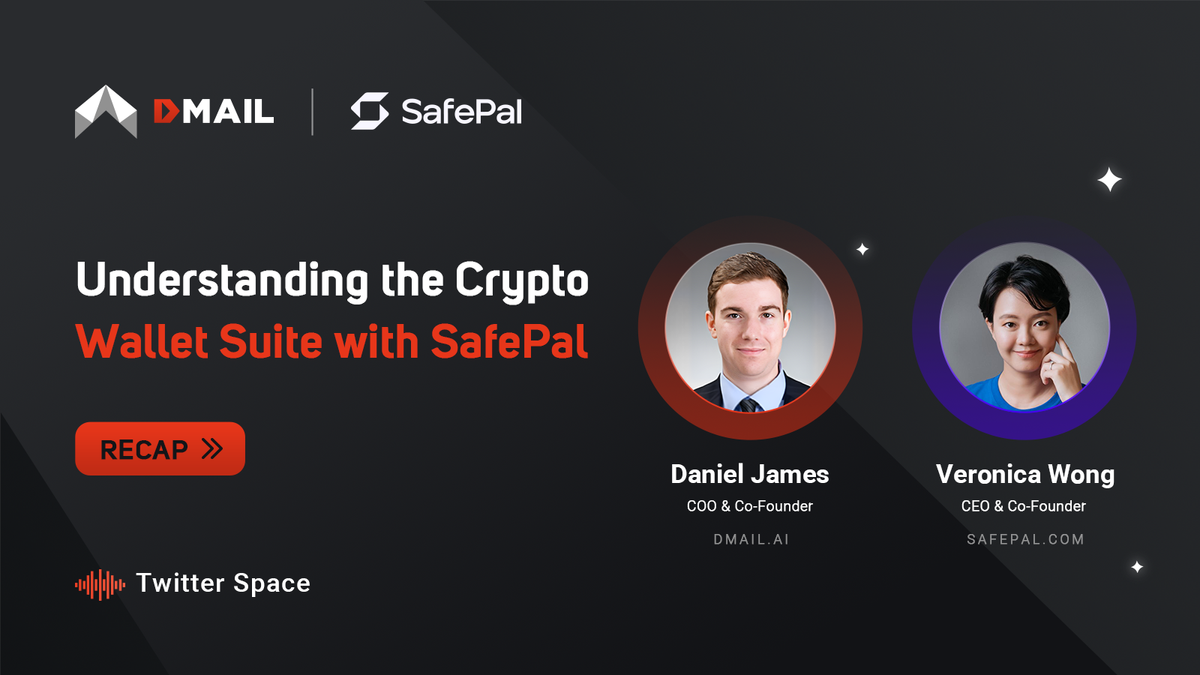Understanding the Crypto Wallet Suite with SafePal
SafePal Walet and Dmail celebrate their partnership and integration by having a discussion about the crypto wallet suite.

You can listen to the full recording here
Part 1 - Introduction to the Discussion
Daniel, COO: We're honored to have Veronica Wong, the CEO of SafePal join us today for an in-depth introduction to their fantastic wallet, which we are excited to announce has now been integrated into Dmail!
SafePal users who log into Dmail will be eligible for a personalized domain freemint of 8-11 digits. These are ordinarily $5.49 but the fee is waived for those using SafePal wallets since we’re so excited about this tremendous recent integration and partnership!
Part 2 - Questions about the project
Introduction- Veronica and SafePal
Daniel: Could you please introduce yourself and provide a brief overview of your project?
Veronica: Hi everyone, I’m Veronica, the CEO, and co-founder of SafePal. I decided to found SafePal about 5 years ago after reading the Bitcoin whitepaper. We started as a hardware wallet but are now a comprehensive wallet suite. We now have a mobile wallet with a seamless experience. We solve daily issues surrounding wallets and we look to empower the entire space.
Overcoming Challenges in Web3 Wallet Adoption:
Daniel:In the realm of web3 wallet usage, challenges like scalability, transaction speed, and preemptive transaction issues have hindered widespread adoption. How do you plan to support products like Dmail, which already have strong ties to wallets, in order to boost mass adoption?
Veronica: Great question. It resonates with our philosophy surrounding ecological partnerships. Wallets are the ecological gateways to the web3 ecosystems which engage with many applications. We need to be highly sensitive to user demands and build something useful. We have to be flexible regarding the latest industry trends. Scamming is also a big issue. Users have trouble with dapp engagement engaging with malicious smart contracts. We do health check campaigns to encourage screening of user behavior. Social interaction is something that plays an important role increasingly. We’re interested in exploring user engagement between wallets and looking forward to something like that with Dmail.
Unique Aspects of Your Wallet:
Daniel: Every wallet possesses its own core technology. Could you highlight what sets your product apart in terms of technology, ecosystem, and community engagement compared to other wallets?
Veronica: This goes beyond the product end, mainly our team needs recognition with immense diverse experience of building incredible products. SafePal has a truly diverse product suite. We aren’t biased between different solutions- we just focus on user experience and we are open-minded to multiple solutions, looking to always implement the most user-friendly approach. We like to put ourselves in users' shoes. We have maintained a solid delivery process- every month we deliver a version update. We have over 10 million users so we seem to be doing something right. We have very intuitive products that evolve rapidly according to the needs of users.
Balancing Security and User Convenience:
Daniel:Striking a balance between security and user convenience is pivotal in wallet development. While technical experts may advocate for longer passwords, users may find it cumbersome. How do you address this to ensure a user-friendly experience?
Veronica: EOA wallets are a mainstream solution with private key management. Some key adjustments related to the private key need precautions. For non-private key wallets, there are ways to smooth the process, like fingerprints, etc. But for EOA we need to educate a lot. We don’t allow copying and pasting for example. We need to protect data usage. Copying addresses from transaction history can be problematic as it can be unsafe due to malicious transactions and transfer it to an unknown address. We adjust and update this on a daily basis, ensuring transfers for example have safety embedded into the UX. It’s difficult to iterate in case of catastrophic issues, but again, that's where the team is pivotal.
Decentralization in Web3 Wallets:
Daniel: The exploration of decentralization in Web3 wallet development is ongoing. As projects emphasize user ownership, wallets are actively working on solutions supporting decentralized identities and transferring control of data to users. What are your insights on this evolving trend?
Veronica: We love this trend which didn’t occur until last year. Most users were using CEXs until recently. But owning your own private key is becoming more attractive. Some people are using both centralized and decentralized solutions. When players like Dmail bring wallet-to-wallet interaction and socialFi to the fore user data will explode and wallet will become more valuable and will record a digital footprint showing personal identity. People will value on chain identity more- this is unstoppable.
Addressing User Experience Challenges:
Daniel:The user experience in the crypto space still faces significant obstacles, including complex interfaces, limited customization options, intricate key management, reliance on centralized intermediaries, and vulnerability to phishing attacks. How does your platform tackle these challenges?
Veronica: There’s no perfect solution. There’s a lot to solve and some things cannot be done from the wallet side alone. Key management MBC and AA elimination of the private key is interesting and represents trends emerging. Fully compliant fiat on and off ramps are important. That’s a hurdle that needs to be overcome. Also, the prevalence of scams mean users need more protection and education and perhaps even regulation. We are taking steps to overcome these issues but there’s still a lot to do that will take time and partnerships. We are therefore looking to work with partners to build useful things to help us improve.
Comparing Hot MPC and AA Wallets:
Daniel:Could you elaborate on the specific distinctions between hot MPC wallets and AA wallets? Additionally, have you implemented or planned any specific strategies for these products?
Veronica: MPC and AA can be confused because they solve private key existence, though they are different. MPC shards your private key into 3 parts in different locations. It focuses on key management. AA on the other hand is built fully on chain- EVM at this stage. It can configure wallet accounts in many different ways. It can set payment limits, paymasters, and send bulk transactions.
From the user's standpoint, they don't feel the existence of private keys. It’s a smooth process. MPC means no single point of failure. AA is highly automatic based on its own demands. MPC is mostly off-chain, whereas AA is fully on-chain- all on smart contracts. Since MPC is off-chain, you don't need to touch the consensus layer on Ethereum, so it’s flexible and matures as a solution.
It’s common as an embedded wallet for gaming. For AA on chain, it’s facing cross-chain challenges in terms of interoperability. So it’s not being adopted as much as MPC. MPC means you have to trust the custodian holding a shard for the sake of your security, but AA doesn’t have this issue.
There’s a possibility to combine MPC and AA- shard your private key and connect to a smart contract AA wallet so you get the benefits of both. Hopefully, we’ll see a combination of both. Right now MPC is cost effective and cross-chain viable as well as scalable as it’s chain agnostic. It’s the reason it’s being adopted faster. However, AA will gain more adoption as L2s enable AA adoption and lower the user entry threshold. I don’t think these two solutions are necessarily in opposition, but can potentially evolve towards a combined usage.
Difference between Hardware and Software Wallets:
Daniel: Being the first hardware wallet company invested in by Binance Labs, could you explain the difference between hardware and software wallets? Given the relatively higher threshold for hardware wallet adoption, how do you plan to encourage more users to adopt hardware wallets?
Veronica: A private key is used on Software, whereas on Hardware it’s stored offline in a physical device. There’s always a software medium though where the physical device talks to the app, and there are different ways in which the transaction is broadcast such as via QR codes and so on. A pro for software is it’s convenient, but it is potentially unsafe as it’s online. I personally put most of my funds into my hardware wallet and store funds into the software wallet for daily transactions.
Closing Remarks and Future Progress:
To wrap up, do you have any final thoughts or early insights you'd like to share with our audience regarding the anticipated progress of your project?
Veronica: Wallet-to-wallet communication and social UX is something we are looking into and we’ll discuss it with Dmail. SafePal combines the security of hardware wallets and the ease of software. Our mobile app is super powerful. Follow us on Twitter!
Stay tuned for more exciting updates from SafePal and Dmail as we embark on this groundbreaking integration!

Connect with Dmail: Website | Twitter | Discord | Github | Telegram





Comments ()